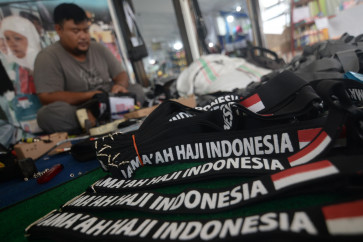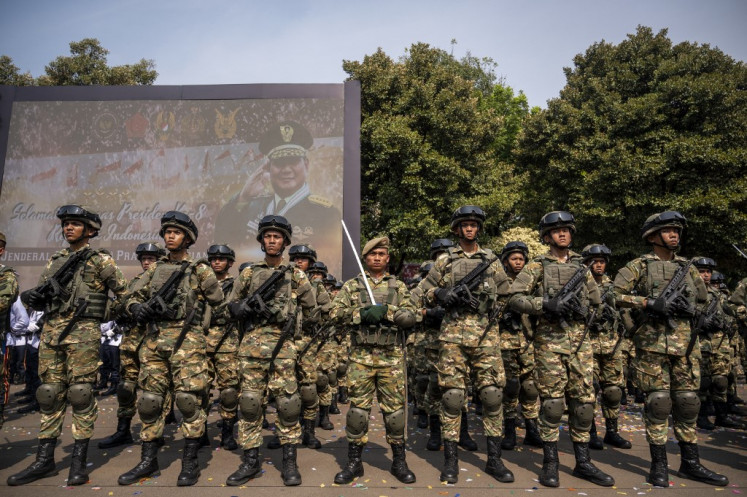Shifting roles of airports in Indonesia
Blast from the past: A Garuda Indonesia airplane is parked at the now-closed Kemayoran International Airport in Central Jakarta
Change text size
Gift Premium Articles
to Anyone

B
last from the past: A Garuda Indonesia airplane is parked at the now-closed Kemayoran International Airport in Central Jakarta. The airport, which was built in 1934 and inaugurated six years later in July 1940, was the first airport in the country to serve international flights.(Kompas.com)
The development of airports in Indonesia began in the early 20th century during the Dutch colonialism era to support its military operation, at the same time the Wright brothers were widely credited for inventing the airplane.
At that time, the colonizer was made aware that wars would mainly involve air strikes and began surveying places to build airfields.
According to the Indonesian Air Force, Suryadarma Air Base, which is named after Suryadi Suryadarma, the first commander in chief of the Air Force, was the first airport to be built in Indonesia. It was built in May 1914, at the same time the Proef Vlieg Afdeling (PVA) was formed. The PVA was part of the the Royal Netherlands East Indies Army (KNIL).
Located in Kalijati, Subang, West Java, the airport was previously named Kalijati Airport before having its name changed in September 2001. The location was chosen because it was in a relatively lesser known area but was also not far from Batavia, or Jakarta, where the colonizer was headquartered.
In March 1942, when the Japanese invaded the country, Kalijati Airport was its first target. After conquering the area, the Dutch gave up its colonization of Indonesia after three decades, and was replaced by the Japanese.
The airport was initially built to house two airplanes the KNIL had procured from the United States. Prior to having an airport, the planes were kept at the naval base in Tanjung Priok, North Jakarta.
In its earlier development, the runway at Kalijati Airport was covered in grass and the ward was made of bamboo. And due to the absence of an adequate hangar, the aircraft deteriorated easily.
Years after the construction of the historic airport, the Dutch also opened an aviation school in that area.
To strengthen its military force, the Dutch observed potential areas in the country to build other airports. Darmo Airport in Surabaya was then opened in 1920.
A year later, an airport was built in Andir, Bandung, West Java. It is now known as Husein Sastranegara International Airport, one of the largest and busiest commercial airports in the country. It is named after one of the initiators of the Air Force, who was killed during flight training in Yogyakarta.
After four years of construction, Tjililitan Airport in East Jakarta, now known as Halim Perdanakusuma International Airport, was officiated in 1924. Its strategic location and stable soil condition were the main reasons why it was chosen. The Dutch called it Vliegeld Tjiililitan, which means airport in their native language.
Currently, aside from commercial flights, Halim airport — which is named after Air Vice-Marshal Halim Perdanakusuma, an Indonesian aviator — is also used for military, private and presidential purposes. More than 5 million passengers use the airport service annually. Private firms providing private and luxurious services also use this airport.
Before the inauguration of what is now Indonesia’s busiest and largest airport Soekarno-Hatta International Airport in 1985, Halim was the country’s main hub of international flights.
To ease congestion at Soekarno-Hatta airport, a slot of up to 60 flights per hour was scheduled for Halim. And for the first time, Haj Pilgrims heading to Saudi Arabia began to embark from this airport in 2013.
But before Halim airport was authorized to serve international flights, the now-ceased Kemayoran Airport in Central Jakarta, was written in history as the first airport in the country to serve international flights.
Built in 1934 and inaugurated in July 1940, Kemayoran Airport had two runways. The KNIL-owned DC-3 Dakota was the first airplane to land in the airport after taking off from Tjililitan Airport.
Due to the need for a bigger airport with a location not too close to the military airport of Halim, the Indonesian government came to the conclusion in the 1970s to build a new airport. Cengkareng in Tangerang, Banten was then chosen to be the site for Soekarno-Hatta airport.
Kemayoran Airport gradually stopped operating from 1983, but its full closure was in 1985 when its bigger, more modern successor in Cengkareng was officially opened.
In the 1950s, after Indonesia won the independence war, the government took over the management of civil aviation and airports. In 1958, it was managed by the Civil Aviation Office, which is now known as the Civil Aviation Directorate General under the Transportation Ministry.
In February 1964, Kemayoran Airport was managed by Perusahaan Negara Angkasa Pura Kemajoran, a state-owned enterprise which eventually became Angkasa Pura (AP) I. Along with AP II, these two state-run enterprises manage a total of 28 commercial airports across the country.
AP I is responsible for operating 14 airports in the eastern part of Indonesia, including I Gusti Ngurah Rai Airport in Bali and the newly built Yogyakarta International Airport in Kulon Progo, to complement the old, overcrowded Adi Sutjipto International Airport in Yogyakarta.
Meanwhile, AP II operates airports in the western part of the archipelago, including Soekarno-Hatta International Airport and the newly inaugurated Kertajati International Airport in Majalengka, West Java.
According to data from hubud.dephub.go.id, the official website of the Civil Aviation Directorate General, there are 297 airports registered, which are spread across 34 provinces throughout the country.
— From various sources









